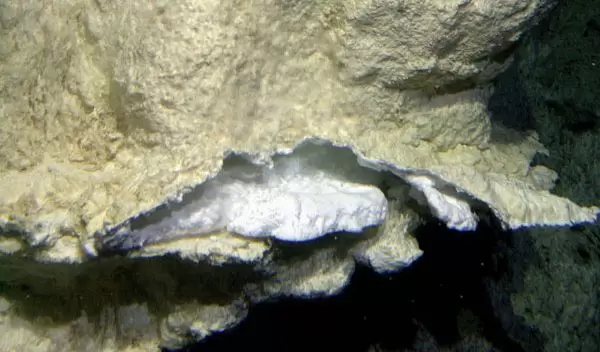
Scientists Discover Secrets of 'Lost City'
Hydrothermal vent structures serendipitously discovered on Dec. 4, 2000, in the mid-Atlantic Ocean, including a massive 18-story vent taller than any seen before, are formed in a very different way than ocean-floor vents studied since the 1970s. This new class of hydrothermal vents apparently forms where circulating seawater reacts directly with mantle rocks, as opposed to where seawater interacts with basaltic rocks from magma chambers beneath the seafloor.
"This discovery is a tremendous example of the results of targeted exploration of the ocean," said Margaret Leinen, NSF assistant director for geosciences. "We knew that the areas of great faults on the seafloor were interesting, but did not realize that hydrothermal activity of this sort could be taking place on seafloor generated millions of years ago."
No one had previously seen a field quite like this, but Deborah Kelley, a University of Washington oceanographer, said this kind of vent may be common on the seafloor. If so, scientists may have underestimated the extent of hydrothermal venting, the amount of heat and chemicals pouring into the world's oceans and the abundance of life that thrives in such conditions.
"Rarely does something like this come along that drives home how much we still have to learn about our own planet," Kelley said. "We need to shed our biases in some sense about what we think we already know."
The Lost City Field, named partly because it sits on the seafloor mountain Atlantis Massif, was discovered during an NSF-funded expedition led by Scripps Institution of Oceanography's Donna Blackman, Washington's Kelley and Duke University's Jeffrey Karson.
Lost City is like other hydrothermal vent systems where seawater circulates beneath the seafloor and gains heat and chemicals until there is enough heat for the fluids to rise buoyantly and vent back into the ocean. As the warm fluids mix with cold seawater the chemicals separate from the vent fluids and solidify, sometimes piling up into impressive mounds, spires and chimneys of minerals.
It was immediately clear, however, that the Lost City Field is unlike other hydrothermal vent systems in a number of ways. First, there is the height attained by some of the structures -- the mighty 180-foot vent scientists named Poseidon compares to previously studied vents that reach 80 feet or less. The new vents are nearly 100 percent carbonate, the same material as limestone in caves, and range in color from a clean white to cream or gray, in contrast to black smoker vents that are a darkly mottled mix of sulfide minerals. And perhaps the Lost City's most distinctive feature is that it is sitting on 1.5 million-year-old crust formed from mantle material.
In the area of the Lost City, spreading and faulting during the last 1 million to 1.5 million years have stripped the mountain down to the underlying mantle rocks. Hydrothermal circulation appears to be driven by seawater that permeates into the deeply fractured surface and transforms olivine in the mantle rocks into a new mineral, serpentine, in a process called serpentinization.
Kelley says it's easy to imagine there could be many more such systems. Within a mere 50-mile radius of the Atlantis Massif are three similar mountains subject to the same fracturing, the same intrusion of seawater and perhaps the same reactions with mantle material. And those four represent only a tiny fraction of the potential sites along the 6,200 mile Mid-Atlantic Ridge, as well as the Indian ridges and the Arctic Ridge, also considered slow- and ultraslow-spreading centers.
-- Cheryl Dybas


